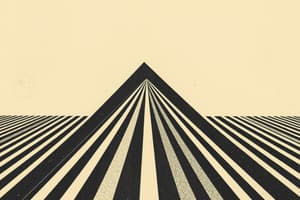Podcast
Questions and Answers
Which of the following statements about lines m and k is true given they are perpendicular?
Which of the following statements about lines m and k is true given they are perpendicular?
- The slopes of lines m and k are equal in magnitude.
- Line m and line k do not intersect.
- Line m and line k have the same slope.
- The product of the slopes of lines m and k is -1. (correct)
When lines m and k intersect, what is the sum of their slopes?
When lines m and k intersect, what is the sum of their slopes?
- 2
- -1
- 0 (correct)
- 1
If line m is perpendicular to line k, which of the following statements could be true?
If line m is perpendicular to line k, which of the following statements could be true?
- Line m and line k intersect. (correct)
- Line m and line k run parallel to each other.
- The slopes of lines m and k are both positive.
- Line m creates an obtuse angle at the intersection with line k.
Which of these characteristics does NOT apply to perpendicular lines m and k?
Which of these characteristics does NOT apply to perpendicular lines m and k?
What can be inferred about the angle created by line m at the intersection with line k?
What can be inferred about the angle created by line m at the intersection with line k?
Which statement is true regarding two lines in the same plane that do not intersect?
Which statement is true regarding two lines in the same plane that do not intersect?
Is it true that if two lines in space do not intersect, they must be parallel?
Is it true that if two lines in space do not intersect, they must be parallel?
Which statement is correct regarding parallel lines?
Which statement is correct regarding parallel lines?
What can be concluded about two lines that are parallel?
What can be concluded about two lines that are parallel?
Which of the following statements is incorrect?
Which of the following statements is incorrect?
Which statement is true regarding points J, K, and L?
Which statement is true regarding points J, K, and L?
What can be said about the segments JK and KL?
What can be said about the segments JK and KL?
Which of the following cannot be concluded based on JK = KL?
Which of the following cannot be concluded based on JK = KL?
If J, K, and L are coplanar, which of the following must also be true?
If J, K, and L are coplanar, which of the following must also be true?
Which statement is NOT a necessary conclusion based on JK = KL?
Which statement is NOT a necessary conclusion based on JK = KL?
Which statement about lines in the same plane is true?
Which statement about lines in the same plane is true?
Which statement regarding lines in space is correct?
Which statement regarding lines in space is correct?
What can be concluded if two lines are parallel?
What can be concluded if two lines are parallel?
Which of the following options is incorrect regarding non-intersecting lines?
Which of the following options is incorrect regarding non-intersecting lines?
What is false about lines that are parallel?
What is false about lines that are parallel?
What is the slope of the longer base of the trapezoid?
What is the slope of the longer base of the trapezoid?
Which point is used to find the equation of the line containing the shorter base?
Which point is used to find the equation of the line containing the shorter base?
Using the point-slope form, which equation represents the line containing the shorter base before simplification?
Using the point-slope form, which equation represents the line containing the shorter base before simplification?
What is the final equation of the line containing the shorter base after simplification?
What is the final equation of the line containing the shorter base after simplification?
If the slope of both bases of a trapezoid is equal, what can be inferred about their lines?
If the slope of both bases of a trapezoid is equal, what can be inferred about their lines?
What is the slope of the longer base of the trapezoid?
What is the slope of the longer base of the trapezoid?
Which equation correctly represents the shorter base of the trapezoid?
Which equation correctly represents the shorter base of the trapezoid?
Given the point (3, 1) on the shorter base, which form of the equation was used to derive its line equation?
Given the point (3, 1) on the shorter base, which form of the equation was used to derive its line equation?
What characteristic do the bases of a trapezoid share?
What characteristic do the bases of a trapezoid share?
What is the vertical intercept of the shorter base's line equation $y =
rac{2}{3}x - 1$?
What is the vertical intercept of the shorter base's line equation $y = rac{2}{3}x - 1$?
What is the result of reflecting rectangle PQRS across the x-axis?
What is the result of reflecting rectangle PQRS across the x-axis?
What is necessary to transform rectangle P'Q'R'S' back to PQRS after reflecting across the x-axis?
What is necessary to transform rectangle P'Q'R'S' back to PQRS after reflecting across the x-axis?
Which transformation would NOT return rectangle P'Q'R'S' to rectangle PQRS?
Which transformation would NOT return rectangle P'Q'R'S' to rectangle PQRS?
After rectangle PQRS is reflected across the x-axis, which point changes its coordinates from (x, y) to (x, -y)?
After rectangle PQRS is reflected across the x-axis, which point changes its coordinates from (x, y) to (x, -y)?
Which transformation sequence describes a method to transform rectangle PQRS back from its reflection P'Q'R'S'?
Which transformation sequence describes a method to transform rectangle PQRS back from its reflection P'Q'R'S'?
Flashcards
Coplanar Points
Coplanar Points
Points that lie on the same plane.
Collinear Points
Collinear Points
Points that lie on the same line.
Midpoint of a Segment
Midpoint of a Segment
A point that divides a segment into two equal segments.
JK = KL
JK = KL
Signup and view all the flashcards
90° Angle
90° Angle
Signup and view all the flashcards
Perpendicular Lines
Perpendicular Lines
Signup and view all the flashcards
Slopes of Perpendicular Lines
Slopes of Perpendicular Lines
Signup and view all the flashcards
Perpendicular Lines, Intersection
Perpendicular Lines, Intersection
Signup and view all the flashcards
Perpendicular Slopes, Sum
Perpendicular Slopes, Sum
Signup and view all the flashcards
Perpendicular Lines
Perpendicular Lines
Signup and view all the flashcards
Non-intersecting lines in a plane
Non-intersecting lines in a plane
Signup and view all the flashcards
Non-intersecting lines in space
Non-intersecting lines in space
Signup and view all the flashcards
Parallel lines and same plane
Parallel lines and same plane
Signup and view all the flashcards
Coplanar lines
Coplanar lines
Signup and view all the flashcards
Skew lines
Skew lines
Signup and view all the flashcards
Parallel Lines (Same Plane)
Parallel Lines (Same Plane)
Signup and view all the flashcards
Non-intersecting Lines (Space)
Non-intersecting Lines (Space)
Signup and view all the flashcards
Parallel Lines & Same Plane
Parallel Lines & Same Plane
Signup and view all the flashcards
Non-Parallel Lines in Space
Non-Parallel Lines in Space
Signup and view all the flashcards
Lines in the Same Plane
Lines in the Same Plane
Signup and view all the flashcards
Trapezoid Base Slopes
Trapezoid Base Slopes
Signup and view all the flashcards
Slope Calculation
Slope Calculation
Signup and view all the flashcards
Parallel Lines
Parallel Lines
Signup and view all the flashcards
Point-Slope Form
Point-Slope Form
Signup and view all the flashcards
Equation of Shorter Base
Equation of Shorter Base
Signup and view all the flashcards
Trapezoid Base Slope
Trapezoid Base Slope
Signup and view all the flashcards
Slope Formula
Slope Formula
Signup and view all the flashcards
Point-Slope Form
Point-Slope Form
Signup and view all the flashcards
Equation of Shorter Base
Equation of Shorter Base
Signup and view all the flashcards
Parallel Bases
Parallel Bases
Signup and view all the flashcards
Transformations for Rectangle
Transformations for Rectangle
Signup and view all the flashcards
Reflection Across x-axis
Reflection Across x-axis
Signup and view all the flashcards
Reflection Across y-axis
Reflection Across y-axis
Signup and view all the flashcards
180° Rotation
180° Rotation
Signup and view all the flashcards
Transformation Combination
Transformation Combination
Signup and view all the flashcards




